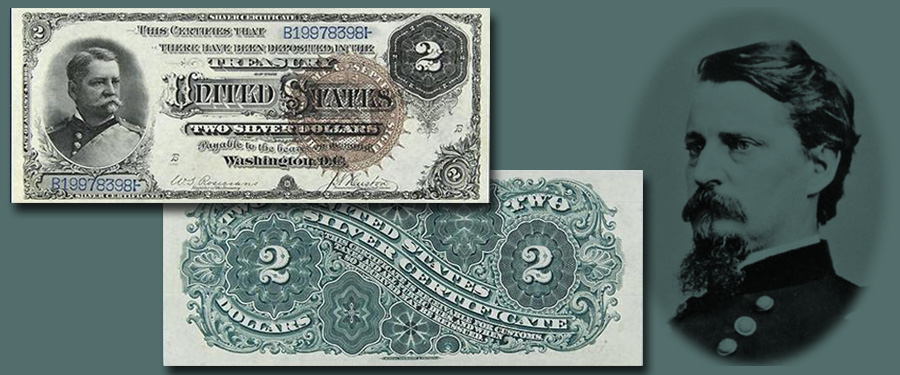
Welcome to our third edition of "Better Know Your Notes." This week we look at the man featured on one of my all-time favorite type notes, Winfield Scott Hancock, who can be seen on Series 1886 $2 Silver Certificates. These ornately designed deuces are sometimes called "Mustache Notes" due to Hancock’s bold facial hair. The notes fall under Friedberg numbers 240 to 244.
Winfield Scott Hancock was born February 14, 1824, in Montgomeryville, Pennsylvania, along with his identical twin brother, Hilary Baker Hancock. His father Benjamin Franklin Hancock named him for another prominent American, General Winfield Scott, the hero of the War of 1812.
Hancock was nominated to the United States Military Academy at West Point in 1840 and he graduated in 1844, 18th in his class of 25. As an officer he earned a commission to brevet second lieutenant and was sent to the Red River Valley of the Indian Territory. In Kentucky he was serving as a recruiter when war with Mexico broke out in 1846. In 1847 he was allowed to leave for Mexico to join his regiment, which fell under the leadership of his namesake, commander of the United States Army General Winfield Scott.
He saw action in battles at Contreras and Churubusco, where he was wounded in the knee. Shortly after he received a promotion to brevet first lieutenant. Despite a lingering fever from his knee wound, he was able to lead his men at the battle of Molino del Rey. Regrettably, he would be unable to participate in the final charge into Mexico City to see the American victory. After the war he held various posts around the country. It was in Southern California where he met and became close friends with a Virginian officer named Lewis Armistead.
When the Civil War broke out in 1861, Armistead and other southerners serving in California with Hancock resigned to join the newly formed Confederate Army. Hancock returned east where he was promoted to brigadier general on September 23. He earned his nick name at the Battle of Williamsburg in 1862 when Maj. General George McClellan sent word to Washington of Hancock’s "superb" action during the battle. Thus the name "Hancock the superb" stuck with him the rest of this life.
Hancock led troops at Antietam, taking over a division after Maj. General Israel Richardson was mortally wounded. Shortly after this he led divisions in the battles of Fredericksburg and Chancellorsville, being wounded in both battles.
Undoubtedly Hancock’s legacy was cemented in 1863 at the Battle of Gettysburg where he entered as a new corps commander under the commander of the Union Army, Maj. General George Meade. Meade ordered Hancock to take command of four corps, basically the left wing of the army, upon the death of his friend Maj. General John Reynolds early on July 1. Hancock organized outnumbered forces in the defense of Cemetery Hill against the Confederate charge. Hancock’s men succeeded and drove the Confederate troops back through the town. The decision to stand and fight even though outnumbered figured greatly in the outcome of the battle.
On the second day of the battle Hancock found himself in the middle of the Union line under attack from Confederate Lt. General A.P. Hill. In fierce fighting Hancock made the difficult decision to sacrifice the 1st Minnesota regiment in a charge outnumbered four to one. Despite heavy losses the charge bought enough time for Hancock’s forces to reorganize a successful defense of the Union line on Cemetery Ridge.
Hancock was again under intense heat from the Confederate assault on Cemetery Ridge on July 3. Hancock’s corps was the primary target of Pickett’s Charge and bore the brunt of the assault. Despite the danger Hancock led his men on horseback directing the defense of the line and motivating battle-weary soldiers. On the other side of the attack, Hancock’s old friend Lewis Armistead, now a brigadier general, was leading a brigade in the charge up the hill when he was struck down, dying in a field hospital two days later. Hancock received word of Armistead’s injuries through a member of his staff but was unable to visit his dying friend as he had been wounded in the leg himself.
Congress recognized Hancock for his bravery after the Battle of Gettysburg and he returned to service for the Battle of the Wilderness and Battle of Spotsylvania Courthouse. After additional action in 1864 Hancock found himself slowed by his wound suffered at Gettysburg and decided to give up field command in November. At the tail end of the war on March 13, 1865, he received a promotion to brevet major general. Later that year Hancock was tasked with supervising the execution of the conspirators of the Lincoln assassination.
After the war Hancock played a key role in the reconstruction efforts commanding the Fifth Military District in Louisiana and Texas. In 1868 he garnered support as a potential Democratic presidential nominee, but could not secure enough delegates to continue his campaign. Still, his popularity increased based on his reputation as a principled man of impeccable character. With the death of General Meade in 1872 Hancock became the army’s most senior commander.
Hancock finally did secure the Democratic nomination for president for the 1880 election. Running against James A. Garfield, Hancock received strong popular support from the Southern states but was unable to carry enough Northern states. Garfield won the election, gaining only 39,213 more votes than Hancock, but with a commanding 214 to 155 lead in the Electoral College.
Following his 1880 presidential defeat Hancock returned to his military post, serving as commander of the Division of the Atlantic, a position he remained in until his death on February 9, 1886. Soon after, Hancock’s portrait appeared on the $2 Silver Certificates of 1886.





